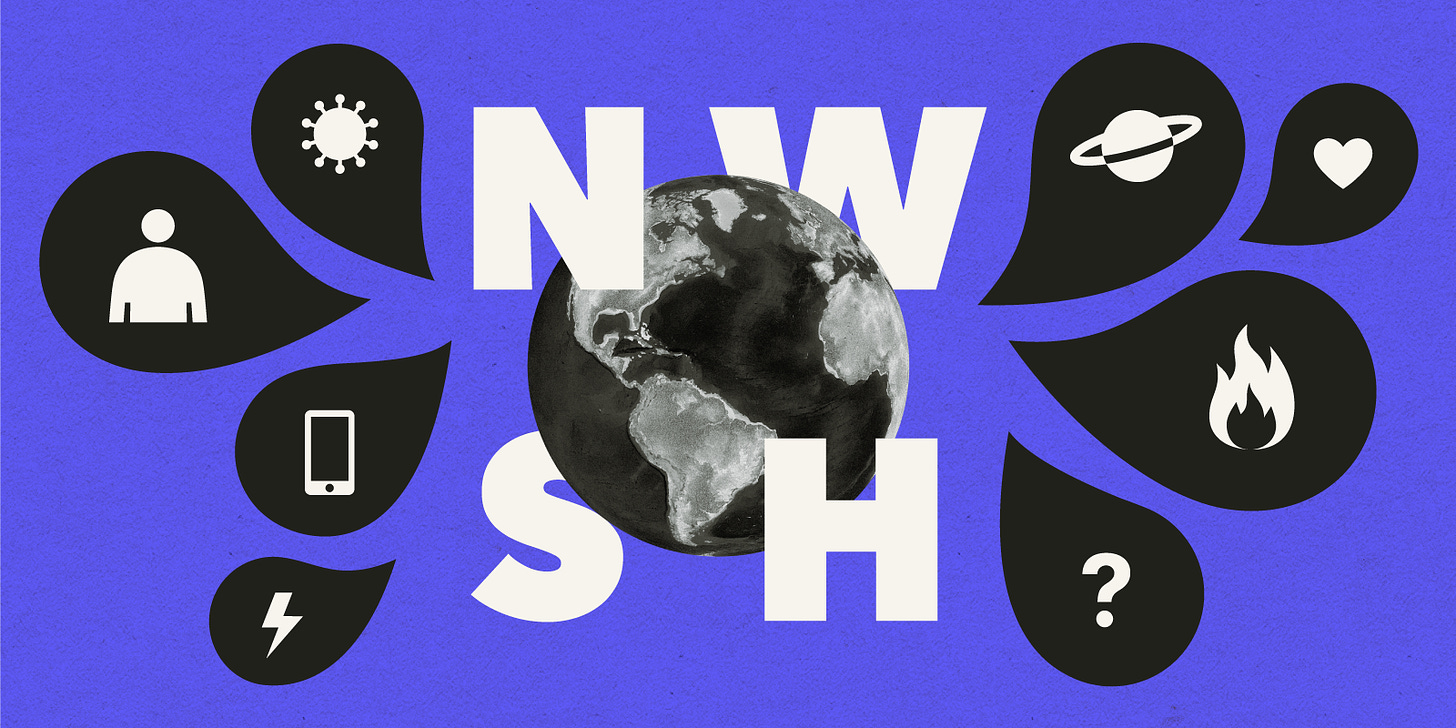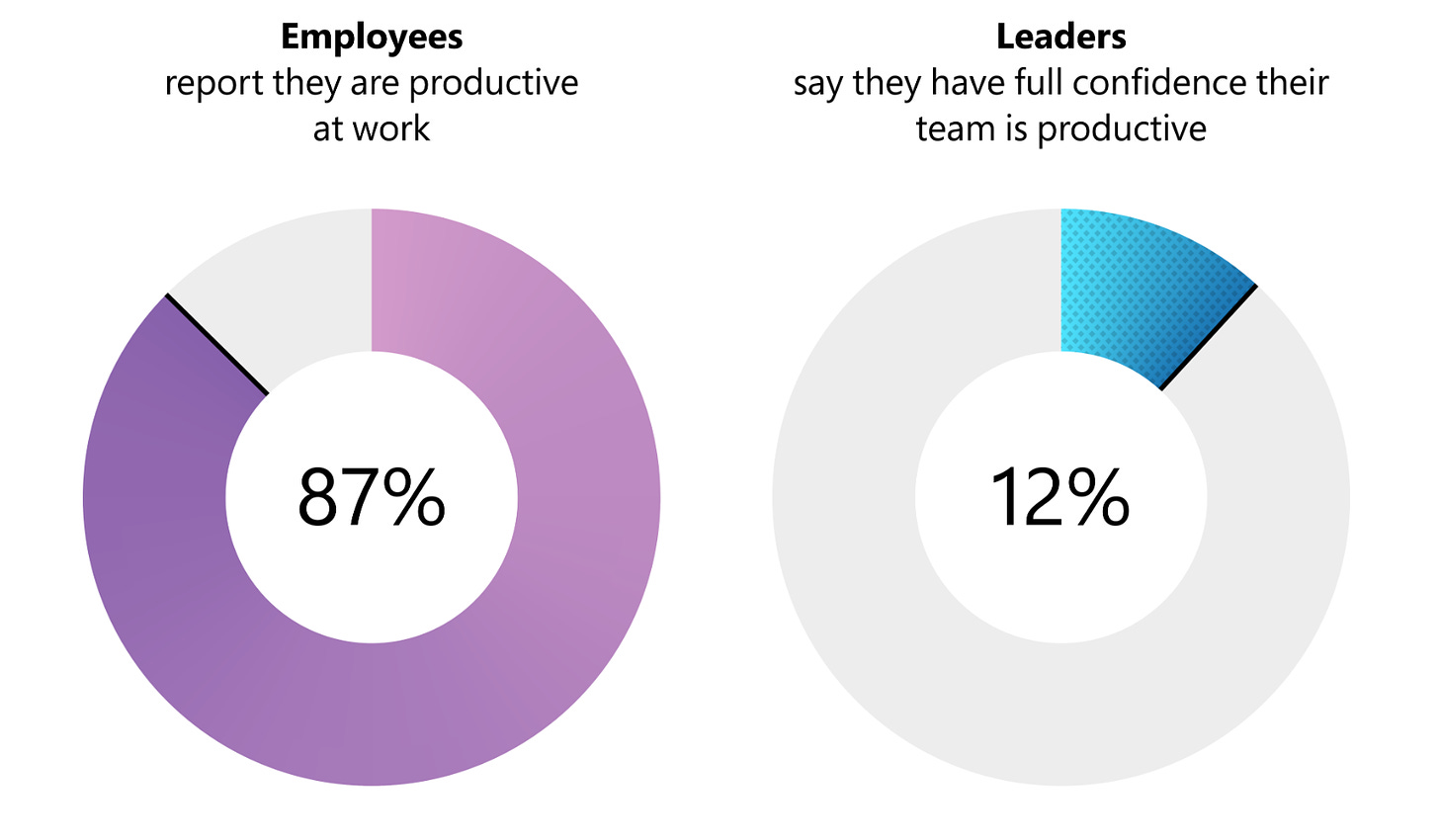Welcome to the mid-week update from New World Same Humans, a newsletter on trends, technology, and society by David Mattin.
If you’re reading this and haven’t yet subscribed, join 22,000+ curious souls on a journey to build a better future 🚀🔮
To Begin
We’ve reached a milestone; 100 instalments of the New Week update from New World Same Humans!
I can’t believe how fast that has flown by. I’ll never tire of saying it: writing to you every week is a huge privilege. Thanks for being part of this community, and I hope you’ll continue to find these updates useful as we push into the next 100 editions.
As promised, I’ll write soon with an updated plan for this newsletter, including the return of the short notes that I used to send on Sundays, and a roadmap for the next instalments of my long essay-almost-book The Worlds to Come.
In the meantime, there’s plenty to talk about this week. Tesla are building a simulation of San Francisco in Unreal Engine 5. New research from Microsoft shows managers are paranoid about their staff slacking off at home. And changes are coming to the voice of Darth Vader.
Let’s get into it.
🏙 Sim city
This week, another glimpse of the way simulations will reshape innovation and much else besides.
Tesla is reportedly using Unreal Engine to create a simulation of San Francisco in which it can test its autonomous cars.
Unreal Engine is the 3D game engine created by Epic Games. It’s best known as the technology that underpins Epic’s Fortnite and a host of other games, and lies at the heart of the software giant’s metaverse ambitions, which have been much-discussed by CEO Tim Sweeney.
Epic recently released Unreal Engine 5. This video, published last month, showcases the level of detail and the scope of the world-building being leveraged by Tesla:
Tesla is using the simulated city to test its Autopilot feature and self-driving technologies without incurring the risks that accompany IRL testing. According to mobility publication Electrek, though, the simulated SF is so compelling that Elon Musk has even considered using it as a basis for the creation of new video games.
⚡ NWSH Take: When we think metaverse — and certainly when we think Unreal Engine — we tend to think entertainment. But NWSH is obsessed with the ways in which simulated and virtual worlds will transform much else besides. Tesla are not the only automaker, for example, leveraging the power of simulations when it comes to innovation; see BMW building a simulated factory inside NVDIA’s Omniverse platform, which they’ll use to model new manufacturing processes. // NVIDIA themselves, meanwhile, are using Omniverse to build Earth-2, a massive simulation of the planetary climate system. That project hints at the goal in view here; the creation of simulations that allow us new insight into highly complex, unpredictable systems. Soon enough, every major city on the planet will be twinned with a mirror image inside a virtual world; that will revolutionise the way we manage traffic flows, public transport systems, power demands, and more. // The dream? It’s the simulation of social systems, including entire societies, in ways that allow us a new understanding of our collective lives. Here in the UK, we’re in the grip of a huge political argument over economic policy. Will such arguments one day be informed by sophisticated simulations of the national economy? We’re at the start of a long journey towards virtual worlds as critical infrastructure and invaluable sources of industrial and political insight. NWSH will keep watching.
👨💻 Paranoid capitalism
How is the Brave New World of hybrid work shaping up? This week, Microsoft published new research that offers an answer.
For its new Work Trend Index report, the tech giant surveyed 20,000 knowledge workers across 11 countries and analysed a ton of data from the Microsoft 365 platform, which offers cloud-based access to apps such as Word and Excel.
The upshot? Managers are worried that their teams are slacking off at home. A full 85% of leaders say ‘the shift to remote work has made it challenging to have confidence that employees are being productive’.
Meanwhile, 87% of employees say they are being productive inside a hybrid work model. And Microsoft say that the ‘productivity signals’ they track across Microsoft 365 have climbed across the last 12 months.
The report gives this disconnect between managers and their teams a name: productivity paranoia.
The phenomenon, say the report authors, threatens the sustainability of the hybrid model. Their answer? Managers should set clear targets, give regular feedback, and reward impact not activity. Sounds great, but I have a feeling productivity paranoia may prove harder to shift than these injunctions imply.
⚡ NWSH Take: Outdated organisational structures are at the heart of this finding from Microsoft. In most companies, management hierarchies are still built around models that evolved during the industrial revolution; think supervisors hovering over workers to ensure they’re making the widgets fast enough. Hybrid work disrupts all that. No wonder managers are in a tailspin; they’re being held responsible for the productivity of people they hardly ever see. The immediate consequence is an explosion in productivity surveillance; new tools that allow managers to track the online activity — sometimes even the cursor movements — of their teams. Some staff are even using ‘mouse jiggling’ tools to get around such oversight. // So is this the future: ever-increasing worker surveillance? Enlightened organisations will surely seek better answers. That can only mean new organisational structures that are suited to a connected world, and that empower staff to take ownership of their own work. Out go rigid managerial hierarchies; in come flexible networks that allow the instant assembly of project teams. Sounds a utopian dream? Wikipedia got built that way. And it’s not a new idea; remember Holocracy, which had a moment in the mid-teens? It may be due a post-pandemic, hybrid work reboot.
🤖 AI am your father
How long can an ageing actor continue to play his most famous role? This week, further evidence that a new answer is emerging: forever, kind of.
James Earl Jones, the actor behind the iconic voice of Darth Vader, is handing over stewardship of the character to machine intelligence.
For the recent Obi-Wan Kenobi series, 91-year-old Jones’s voice was enhanced by the Ukrainian AI voice generation startup Respeecher. Now, Jones says he will permanently retire from the role. But he’s signed over his archival voice recordings to to Respeecher, so they and Disney — who own the Star Wars franchise — can create an AI version of his Darth Vader voice to use in future productions.
Respeecher are creating an all-purpose AI voice platform; they envisage a future in which famous actors and ordinary content creators deploy cloned versions of their voices. It raises the possibility of films, TV shows, and podcasts spoken entirely by voice clones:
‘Human actors don’t have to do much aside from speaking a certain number of words using different cadences during a recording session. Once the neural network has enough speech to create an artificial voice model, the actor’s job is done.’
The startup also created a voice for the young Luke Skywalker in 2021’s The Book of Boba Fett. And two weeks ago they provided the spoken voice of Elvis for virtual humans startup Metaphysic’s performance in the final of America’s Got Talent, which I wrote about in New Week #98.
⚡ NWSH Take: Another startup on the frontlines of a NWSH obsession: the way that AI is set to allow actors, singers, and artists a strange new kind of ghostly creative afterlife. I first wrote about this via the AI reincarnation of South Korean folk singer Kim Kwang-seok, and I’ve been tracking it ever since. This news on James Earl Jones, though, throws a couple of issues into sharp relief. // First, Jones signed over the rights to his voice to Disney and Respeecher. Nothing has been reported on if, or how much, he was paid for those rights. But it’s clear that this new age of AI reincarnation will mean new revenue streams for both living creatives and the estates of those who’ve died. If the price is right, will Elvis voice a character in a future Disney animated film? // Meanwhile, Disney has been criticised for the move because it will deprive a human actor of the chance to take the Darth Vader role. Rewind a few years and remember the jobs you expected to be automated away by AI: acting probably didn’t feature. Now, thanks to tools such as Respeecher, and the stunning advances made by natural language and language-to-image models, the creative and arts industries are set to reshaped by machine intelligence. We’re witnessing the birth of entirely new art forms. But more controversy, including criticism from creatives who feel marginalised, surely lies ahead.
🖼 Animate this
In haste, just before I hit send on this week’s instalment: here’s another example of the ongoing collision between AI and human creativity.
Meta just released a new AI model that generates short video clips — something akin to gifs — based on text prompts:

AI image generators such as OpenAI’s DALL-E and Midjourney are already changing the way we think about the visual arts. Now Meta is the first to extend these AI models to video generation.
The teddy bear clip above was generated via nothing more than the text prompt ‘a teddy bear painting a portrait’. It’s not hard to imagine how you might tie a series of prompts together to create an entire three-minute cartoon featuring this little bear.
The implications for the animation arts and multiple industries — TV, film, advertising — are vast. These AI advances are coming so fast, now, that it’s dizzying. More from NWSH soon.
🗓️ Also this week
🦖 The CIA invested in Colossal Biosciences, the DNA startup that wants to resurrect the woolly mammoth. The investment came via In-Q-Tel, the CIA’s venture capital fund, which invests in companies with the potential to enhance national security. In a blog post In-Q-Tel explained its interest in biosciences startups developing technologies that will, for example, allow for new bioengineered solutions to climate change. Colossal, who I wrote about in New Week #52, are also working to resurrect the Tasmanian tiger.
🛩 A US startup conducted the world’s first test flight of an all-electric passenger plane. The prototype jet, called Alice, flew for eight minutes; it’s the creation of Washington-based startup Eviation, who say they hope eventually to fly electric passenger jets between US cities.
⚛ Germany says it will keep two of its nuclear plants running for longer than planned. The government says two of its remaining three plants — Isar 2 in Bavaria, and Neckarwestheim in Baden-Württemberg — will keep running until at least April 2023. The energy crisis sparked by Russia’s invasion of Ukraine has raised concerns that Germany may face an electricity shortfall over the winter.
💭 Sci-fi author Neal Stephenson’s new startup published its vision for the future of the metaverse. Stephenson coined the term ‘metaverse’ in his iconic 1992 novel Snow Crash. In a new white paper, his startup Lamina1 says it wants to build an ‘open metaverse’ that ‘provides communities with infrastructure, not gatekeepers’.
🚗 New York says it will ban the sale of petrol-powered vehicles by 2035. According to an official 2021 report, transportation accounts for 28% of the state’s greenhouse gas emissions. The move sees New York become the second state to vow a ban on petrol cars, after California.
😴 Amazon launched a new device that track’s the user’s breathing while they sleep. The Halo Rise also tracks room temperature, humidity and light, and is intended to allow users new insight into their sleeping patterns.
🚌 Bus drivers in Beijing have been told they must wear wristbands that track their emotional and attention states. The wristbands are being issued by the Beijing Public Transport Holding Group, and will measure heart rate, body temperature, and movement among other metrics. The Group say the move will ‘protect public safety’. In Algorithms With Chinese Characteristics I wrote about the CCP’s obsessive drive to create a new form of tech-fuelled total state oversight.
🌍 Humans of Earth
Key metrics to help you keep track of Project Human.
🙋 Global population: 7,977,880,086
🌊 Earths currently needed: 1.7896988827
💉 Global population vaccinated: 62.6%
🗓️ 2022 progress bar: 75% complete
📖 On this day: On 30 September 1968 the Boeing 747 is revealed to the public for the first time at the Everett factory near Seattle, USA.
The Force is Strong
Thanks for reading this week.
The ongoing collision between AI, simulations, and human creativity is yet another case of new world, same humans.
This newsletter will keep watching. And there’s one thing you can do to help: share!
Now you’ve reached the end of this week’s instalment, why not forward the email to someone who’d also enjoy it? Or share it across one of your social networks, with a note on why you found it valuable. Remember: the larger and more diverse the NWSH community becomes, the better for all of us.
I’ll be back next week. Until then, be well,
David.
P.S Huge thanks to Nikki Ritmeijer for the illustration at the top of this email. And to Monique van Dusseldorp for additional research and analysis.
















New Week #100